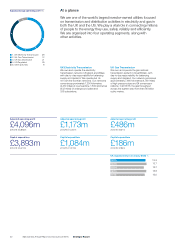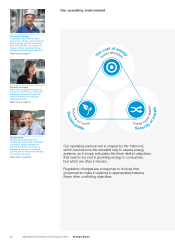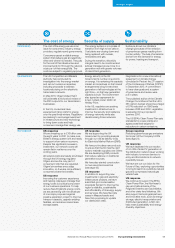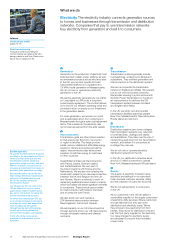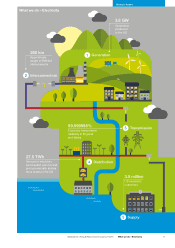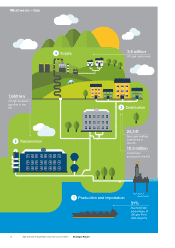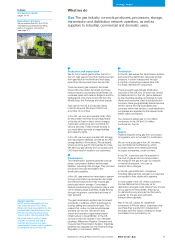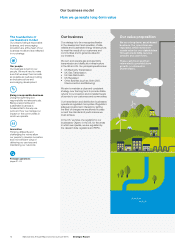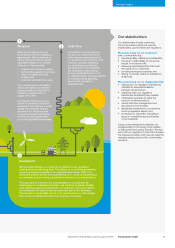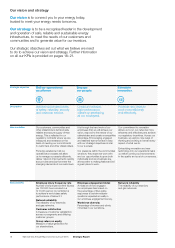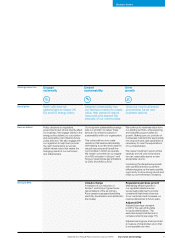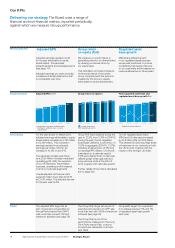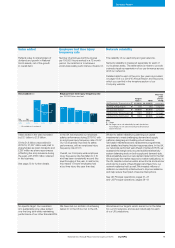National Grid 2016 Annual Report Download - page 11
Download and view the complete annual report
Please find page 11 of the 2016 National Grid annual report below. You can navigate through the pages in the report by either clicking on the pages listed below, or by using the keyword search tool below to find specific information within the annual report.
The cost of energy Security of supply Sustainability
Commentary The cost of the energy we use is an
issue for consumers, industry, energy
providers, regulators and governments.
Consumers expect a reliable energy
system that delivers gas and electricity
when and where it is needed. They pay
for the cost of this infrastructure and
improvements to it through the network
costs part of their energy bills. The
costs are subject to regulatory approval.
The energy system is in a phase of
transition from high to low carbon.
Coal plants are closing down and
being replaced with nuclear,
renewables and gas.
During the transition, electricity
margins need to be monitored and
actively managed as we move to a
generation mix with greater volumes
of intermittent generation.
Evidence shows our climate is
changing because of the emission
of greenhouse gases resulting from
human activity. The bulk of emissions
derive from the demand for energy
for power, heating and transport.
Developments The UK Competition and Markets
Authority has concluded its
investigation into the energy market
and set out numerous remedies,
including proposals to address
locational pricing on the electricity
transmission network.
In May 2016, Ofgem stated that it
will undertake a mid-period review of
the RIIO outputs for our transmission
businesses.
In the US, consumers have
experienced rising costs for energy
over the past three winters. Regulators
are seeking to encourage investment
in infrastructure and new technology
to bring down costs and help
consumers manage their energy use.
Energy security is the UK
Government’s number one priority
on energy. It is reviewing the capacity
market and incentives so that market
arrangements bring forward new
generation of all technologies at the
right time – so that new generation
capacity is built. The Government
also signed an agreement for
a new nuclear power station at
Hinkley Point.
In the US, regulators are seeking
investment in infrastructure to
improve the security and resilience
of energy networks while also
decarbonising those networks.
Negotiations for a new international
agreement on climate change
concluded in Paris at the 21st session
of the Conference of Parties (COP21)
in December 2015. A commitment
to have clear goals and a system
of governance and review were
put in place.
The published advice of the Climate
Change Committee is that the UK’s
fifth carbon budget should be a target
of 57% reduction on 1990 levels
between 2028 and 2032. Legislation
is expected to be proposed in
summer 2016.
The US EPA’s Clean Power Plan sets
standards for power plants and
agrees state level targets for
reductions in carbon emissions.
Our response UK response
We are investing up to £16 billion over
the eight years to 2021 to make sure
Britain’s energy system is fit and ready
to support a low-carbon economy.
Despite this significant increase in
investment, our network costs will
remain flat in real terms over the
coming years.
All network costs are heavily scrutinised
through the UK energy regulator
Ofgem and are the only part of
consumers’ bills that are regulated.
Ofgem’s incentives encourage
innovation, so if we are more efficient,
consumers share the benefits.
US response
Improving the customer experience
and helping ratepayers manage their
energy costs is a critical component
of our business operations. To help
reduce New England’s energy costs,
we are partnering with the developer
of one major proposed regional
pipeline expansion project to improve
transport capacity, upgrade existing
facilities, and enhance market area
storage assets.
UK response
We are supporting the UK
Government by providing analysis
through our role as delivery body
for Electricity Market Reform (EMR).
We have put in place new products
to ensure that the SO has the right
tools to maintain supplies over winter.
We are developing DSR products
that reduce reliance on traditional
generation sources.
We have also started construction
on two new interconnectors
(see page 43).
US response
In addition to supporting new
investments in gas and electricity
infrastructure projects, we have
submitted grid modernisation
proposals that aim to improve the
region’s reliability, sustainability
and affordability of its energy supply
and services. We have filed rate
cases in Massachusetts and
New York proposing to update
our distribution rates.
Group response
Reducing greenhouse gas emissions
forms part of the Company’s KPIs
(see page 21).
UK response
We have facilitated the connection
of 4.5 GW of solar PV generation at
the distribution network level, working
with industry to remove barriers to
entry and find solutions to network
operability issues.
We have set out our vision for the
Future of Gas, exploring opportunities
to bring forward bio-substitute natural
gas and compressed natural gas
vehicle fuels.
US response
We continue to support the EPA’s
Clean Power Plan, the Northeast’s
cap-and-trade scheme of the
Regional Greenhouse Gas Initiative,
and other state-level initiatives. We
also support technological partners
and innovative tools, such as energy
storage, electric transportation and
distributed generation, which can
help meet sustainability and energy
diversity objectives.
09National Grid Annual Report and Accounts 2015/16
Strategic Report
Our operating environment




